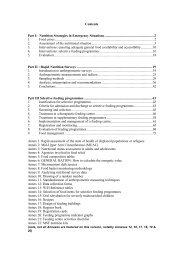UNHCR Handbook for Emergencies - UNHCR eCentre
UNHCR Handbook for Emergencies - UNHCR eCentre
UNHCR Handbook for Emergencies - UNHCR eCentre
You also want an ePaper? Increase the reach of your titles
YUMPU automatically turns print PDFs into web optimized ePapers that Google loves.
44<br />
<strong>for</strong> details of how to access <strong>UNHCR</strong> emergency<br />
response resources. With the government, the<br />
resources of other UN organizations, particularly<br />
UNICEF and WFP, and of the NGO sector<br />
must be mobilized within the framework of a<br />
plan <strong>for</strong> immediate action.<br />
Protection<br />
20.<br />
Unless the refugees’ right to asylum is<br />
assured there can be no assistance programme.<br />
Action must be taken to this end, and to ensure<br />
their security and fundamental human<br />
rights. The importance of a <strong>UNHCR</strong> presence<br />
where the refugees are located has been<br />
stressed. Specific measures may be needed, <strong>for</strong><br />
example to meet the special protection problems<br />
and needs of groups at risk (unaccompanied<br />
children, single young girls, minorities,<br />
etc.), and to protect the refugees against arbitrary<br />
actions of outsiders and against groups<br />
within their own number who may pose a<br />
threat to their safety.<br />
Organizational Considerations<br />
21. <strong>UNHCR</strong> must establish a presence where<br />
the refugees are, with assured communications<br />
with the main office and with Headquarters.<br />
The organization of the necessary logistical<br />
capacity to deliver the assistance will be<br />
of critical importance.<br />
22. The priority, once problems and needs<br />
have been assessed, will be to provide vital<br />
assistance wherever the refugees are located.<br />
There will also, however, be key organizational<br />
or planning decisions to take, some of which<br />
may determine the future shape of the whole<br />
operation. These often include the points summarized<br />
below; decisions on them should be<br />
seen as a part of the immediate response.<br />
If such decisions go by default or are wrong<br />
they will be very difficult to correct later.<br />
Protection and Material Assistance<br />
The Location of the Refugees<br />
23. This will have a major influence on protection<br />
and all sectors of assistance. If the refugees<br />
have spontaneously settled in a scattered manner,<br />
they should not be brought together<br />
unless there are compelling reasons <strong>for</strong> breaking<br />
their present settlement pattern. If they are<br />
already in sites which are judged to be unsatis-<br />
factory, move them. The difficulty in moving<br />
refugees from an unsuitable site increases<br />
markedly with time. Even if those already there<br />
cannot be moved, divert new arrivals elsewhere<br />
(see chapter 12 on site planning).<br />
Control at the Sites<br />
24. Determine the optimum population in<br />
advance and plan <strong>for</strong> new sites accordingly.<br />
Keep careful control of actual occupation of<br />
the site as refugees arrive, so that sections<br />
prepared in advance are filled in an orderly<br />
manner.<br />
Numbers and Registration<br />
25. An accurate estimate of numbers is a prerequisite<br />
<strong>for</strong> effective protection and assistance.<br />
Efficient delivery of help to all in need will<br />
require at least family registration which should<br />
be organized as soon as possible. Nevertheless<br />
the initial provision of assistance may have to<br />
be based on a population estimation rather<br />
than full registration (see chapters 11 and 13 on<br />
registration and commodity distribution).<br />
Urgent Survival Needs<br />
26. Meet the most urgent survival needs:<br />
food, water, emergency shelter, health care<br />
and sanitation, ensuring fair distribution:<br />
i. Involve the refugees and promote their<br />
self-reliance from the start. If this is not<br />
done the effectiveness of the emergency<br />
assistance will be severely reduced, and an<br />
early opportunity to help the refugees to<br />
start to recover from the psychological<br />
effects of their ordeal may be missed;<br />
ii. Food. Ensure that at least the minimum<br />
need <strong>for</strong> energy is met; a full ration can<br />
follow. Set up special feeding programmes<br />
if there are clear indications of malnutrition.<br />
Establish storage facilities;<br />
iii. Water. Protect existing water sources from<br />
pollution and establish maximum storage<br />
capacity with the simplest available means.<br />
Transport water to the site if the need<br />
cannot otherwise be met;<br />
iv. Emergency shelter. Meet the need <strong>for</strong> roofing<br />
and other materials from local sources<br />
if possible. Request outside supplies (e.g.<br />
plastic sheeting) if necessary;<br />
v. Health care. Provide the necessary organizational<br />
assistance, health personnel and<br />
basic drugs and equipment in close consultation<br />
with the national health authorities.



